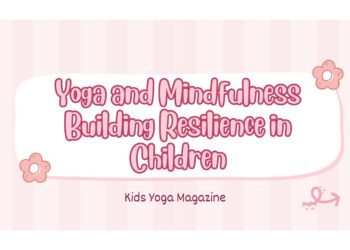In a world full of distractions, from screens to busy schedules, children often find themselves caught up in the hustle and bustle of everyday life. They may worry about the future or dwell on past events, leaving little room for simply being present in the moment. Yoga offers a powerful way to teach kids the importance of mindfulness—being fully engaged in the here and now. By focusing on their breath, movements, and the sensations in their bodies, children can learn to appreciate the present moment, reducing stress and enhancing their overall well-being.
1. Yoga Encourages Mindful Breathing
One of the foundational elements of yoga is mindful breathing. Teaching children to focus on their breath is one of the simplest and most effective ways to help them stay present. When children concentrate on their breathing, they naturally bring their attention to the present moment.
- Breathing Techniques: Exercises like Balloon Breathing or 4-7-8 Breathing help kids focus on their inhale and exhale, creating a rhythm that calms the mind. As they breathe deeply and mindfully, they learn to connect with their bodies and the current moment, letting go of distractions and worries.
- Pranayama Practice: In yoga, pranayama refers to the regulation of breath. Introducing simple pranayama techniques to kids, such as alternate nostril breathing or deep belly breathing, can further enhance their ability to stay present and calm.
Benefit: Mindful breathing teaches children to focus on the now, reducing anxiety and helping them manage their emotions more effectively.
2. Yoga Poses Foster Body Awareness
Yoga poses, or asanas, require children to pay close attention to their bodies—their posture, alignment, and the sensations they experience as they move. This focus on physical awareness draws them into the present moment, helping them to fully engage with their practice.
- Balancing Poses: Poses like Tree Pose (Vrksasana) or Warrior III (Virabhadrasana III) require concentration and balance. As kids work to maintain their stability, they learn to focus on their body’s position and the sensations in their muscles, keeping them anchored in the present.
- Grounding Poses: Poses like Mountain Pose (Tadasana) or Child’s Pose (Balasana) help children feel grounded and connected to the earth. These poses encourage them to focus on the sensations of their feet on the ground or the stretch in their back, reinforcing the concept of being present.
Benefit: By fostering body awareness, yoga helps children develop a deeper connection with themselves and their physical experience, enhancing their ability to stay mindful.
3. Yoga Promotes Mindful Movement
Unlike many other forms of exercise, yoga emphasizes mindful, deliberate movements. Children are encouraged to move slowly and with intention, paying attention to how their bodies feel as they transition from one pose to the next. This practice of mindful movement teaches kids to stay focused on the present task.
- Flow Sequences: Simple yoga sequences like Sun Salutations (Surya Namaskar) can be taught in a way that emphasizes mindfulness. As children flow through the poses, they can be encouraged to synchronize their movements with their breath, creating a moving meditation that keeps them present.
- Yoga Games: Incorporating playful yoga games that focus on slow, controlled movements can help children enjoy the practice while learning to be mindful. For example, “Yoga Freeze Dance” where kids freeze in a pose when the music stops, encourages them to pay attention to their body’s position and balance.
Benefit: Mindful movement in yoga helps children stay engaged in the present, improving their focus and reducing stress.
4. Yoga Integrates Mindfulness with Play
For children, play is a natural way to learn and explore the world. Yoga can be integrated with playful activities that teach mindfulness in a fun and engaging way. This approach helps children associate mindfulness with positive experiences, making it easier for them to embrace the practice.
- Storytelling Yoga: Creating yoga sessions that incorporate storytelling allows children to immerse themselves in a narrative while practicing mindfulness. For example, a jungle adventure story where they become different animals through yoga poses helps them stay present and engaged.
- Animal Poses: Teaching kids animal poses, like Cat-Cow (Marjaryasana-Bitilasana) or Downward-Facing Dog (Adho Mukha Svanasana), encourages them to embody the movements and characteristics of animals. This playful approach keeps them focused on their movements and breath, fostering mindfulness.
Benefit: By combining mindfulness with play, yoga helps children learn to be present in a way that is natural and enjoyable for them.
5. Yoga Teaches Emotional Awareness and Regulation
Yoga also offers tools for emotional regulation, which are closely tied to being present. When children practice yoga, they learn to observe their emotions without judgment, acknowledging how they feel in the moment rather than being overwhelmed by those feelings.
- Mindful Reflection: After a yoga session, children can be guided through a brief reflection on how they feel. This practice helps them identify and understand their emotions, promoting emotional intelligence and mindfulness.
- Relaxation Techniques: Techniques such as Savasana (Corpse Pose) at the end of a yoga practice encourage children to relax fully and tune into their body and mind. This relaxation allows them to process their emotions and release tension, reinforcing the benefits of staying present.
Benefit: Yoga teaches children to recognize and regulate their emotions, helping them stay calm and present even in challenging situations.
Conclusion
Yoga is a powerful tool for teaching children the importance of being present. Through mindful breathing, body awareness, mindful movement, playful integration, and emotional regulation, yoga helps kids develop the skills they need to stay focused and grounded in the present moment. These practices not only reduce stress and anxiety but also enhance children’s overall well-being, helping them navigate life’s challenges with confidence and calm. By incorporating yoga into their routine, children can learn to appreciate the here and now, cultivating a mindful and balanced approach to life.










